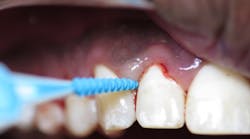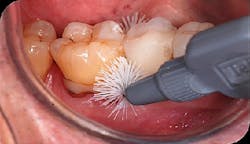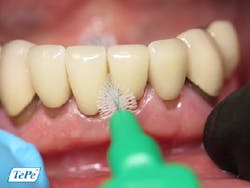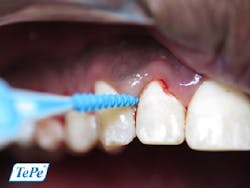5 routine things we do in the dental profession that do not make sense
As dental professionals, most of the work we do as a matter of routine may be considered insane. For example, we work in a small dark area all day; we are constantly told that patients would rather be other places; and we are members of one of the most feared professions. Nonetheless, Albert Einstein defined insanity as doing the same thing over and over and expecting different results. Can this definition be applicable to dentistry? Let’s take a look at five ways we are doing the same thing over and over in dentistry while expecting a different result each time:
ALSO BY B. MICHELLE STRANGE | Dental hygiene nightmares no more: At-home maintenance for success with dental implants
1. Telling people to floss
By now, it would seem that everyone has heard about the flossing debacle that the Associated Press started, yet so many still haven’t heard the news that not every individual’s teeth would benefit from floss. Dental professionals continue to say: You have to brush two times a day and floss between your teeth. It is a broken record in a majority of dental practices that produces the same result—patients continue not to floss. The time has come to help patients find a way to clean between their teeth and manage their oral health. (1) Stepping away from the monotonous flossing recommendation and suggesting products such as properly sized interdental brushes (figures 1 and 2), oral irrigation, or on-the-go solutions (figure 3) that can be easily kept in a pocket or desk drawer would be efficacious of the dental profession. Each patient is different, and the days of asking everyone to floss, knowing that some paitents may not be compliant or have the dexterity to perform the task, is insanity. Approaching interdental care in a more pragmatic way by finding a product or combination of products that are easy to use and deliver better results is a great way to break away from the insane practices we ask our patients to do.
Figure 1: Larger grey TePe interdental brush used in an area where previous inflammation has caused attachment loss.
Figure 2: Crown margins and root surface decay are issues for many. Properly sized interdental brushes can clean the surfaces better than flossing alone.
Figure 3: On-the-go options are a great solution for patients to keep handy in their pocket and use throughout the day.
2. Placing implants in patients who cannot manage to clean their natural teeth
Dental implants are the shiny new toys in the dental professional’s toy box, and they are here to stay. Unfortunately, dental professionals are quick to suggest and place dental implants without properly communicating to patients their responsibility in the implant’s long-term success. This creates a situation ripe for failure. (2) Proper at-home maintenance of a dental implant is vital, but we still hear professionals tell patients to clean it like a natural tooth. The anatomy of a natural tooth is different from that of an implant. Implants may require different products, daily regimens, and more frequent trips to the dentist to ensure success. When looking at a patient’s mouth and how they care—or cared for—their natural dentition should direct the conversation and treatment plan process. Making sure the patient is on board with the proper at-home maintenance regimen is crucial. Placing an implant and thinking it will be more successful in a mouth with poor at-home care is insane.
3. Putting little emphasis on the products in the patient’s goody bag
Dental practices have a tendency to use certain products or limit their take-home products to just a few items, especially the ones that are patient giveaways. Typically, the giveaways that go home in patients’ goody bags are ones that the office received free or got a discount on, without much thought on how they reflect on the practice. Dental professionals tend to put more value on items that the patient typically doesn’t see. For instance, they use the best composite material, the best dental implant system, the best cement for crowns, etc., but place little thought on the products that the patient takes home and associates with the practice. Dental professionals ask patients to trust that they did great work in their mouth, and then ask them to manage that dental work with a toothbrush that they may not actually endorse or one that may not be the best for that patient’s needs. (3,4) Ending a dental appointment that may have gone well with expensive materials used, then sending the patient home with just any home-care tool and asking that patient to believe in the service they received that day is absurd.
4. Believing that everyone needs to have fluoride
These days everyone has an opinion on fluoride. Whether you are for or against the daily application of fluoride, dental professionals need to be armed with other suggestions for those patients who are not interested. Telling a mom whose child is in the chair with multiple cavities that fluoride is the only way is wrong. Fluoride is not the only option these days, and trying to push it on those who are not interested and expecting them to simply change their minds is lunacy. In February 2015, Anne Guignon wrote a great article naming five fluoride-free products that could be suggested to patients who are not interested in fluoride. (5) Give your patients options instead of an argument. The same conversation at each appointment will not deliver results, but meeting patients where they are in their ideologies can.
5. Keeping everyone on a three- or six-month recall
It is no mystery that patients want only what their insurance will pay for, and that includes the frequency in seeing their dental provider. However, not every patient is meant to maintain their oral health with the standard three- or six-month recall. (4) Allowing patients to come in for their six-month “bloody prophy” and hope that within the next six months something with change and they will become healthy is madness. It can be exasperating to be mindful of the fact that insurance coverage dictates most patients’ decisions while at the same time trying to educate patients about the importance of more frequent dental visits. Dental professionals must not become complacent in their recommendations for dental visit frequency. Tailoring treatment to what each individual needs is key, even if your patient doesn’t agree to it.
Thinking outside of the box and providing a more patient-centered type of treatment will help stop the insanity of the routines of dentistry. If the recommendations that we give patients time and time again are not producing needed results, why continue to give them? Helping patients find the best way to achieve their oral health—on an individual basis—will help redefine the future of dentistry.
References
1. Chapple IL, Van der Weijden F, Doerfer C et al. Primary prevention of periodontitis: managing gingivitis. J Clin Periodontol. 2015;42(S16)S71-76. doi: 10.1111/jcpe.12366.
2. Massad JJ, Swati A, Goodacre CJ. Implants and Prosthetic Restorations: Clinical Considerations. Oral Health. http://www.oralhealthgroup.com/features/implants-and-prosthetic-restorations-clinical-considerations/. Published July 1, 2015. Accessed February 2, 2017.
3. Schechter B. Selling home care. Dental Economics. 2000;90(8).
4. Bidra AS, Daubert DM, Garcia LT et al. Clinical practice guidelines for recall and maintenance of patients with tooth‐borne and implant‐borne dental restorations. J Prosthod. 2016;25(S1):S32-S40. doi: 10.1111/jopr.12416.
5. Guignon AN. Fluoride-free products that patients will love. RDH Magazine. 2015;35(2).




